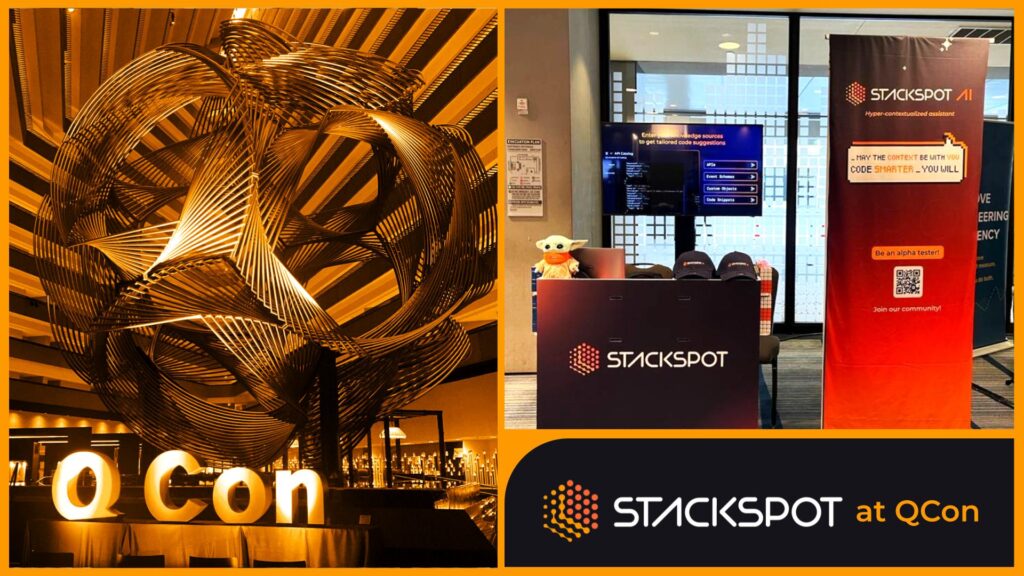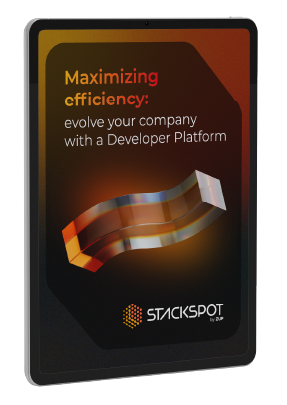StackSpot attended the QCon San Francisco 2023 in early October. The event brought together software developers, technical managers and senior engineering professionals.
The conference offers the opportunity to find new solutions, learn about innovations, and find inspiration in talks given by top leaders and experts.
Our team members —Itaú Unibanco’s Head of Product Manuela Leoni, StackSpot’s Product Manager João Batista Cordeiro Neto, and StackSpot’s Sales Engineer Lucas Vicenzotto— were involved in several tasks, such as talking about technology strategies at our booth, talking to the public, and closely following the event.
Based on this experience, team members shared their biggest insights during the QCon San Francisco 2023. Check them out!
- Generative AI: Shaping a New Future for Fraud Prevention
Manuela started the first day at QCon San Francisco 2023 by attending a keynote presentation by Oscilar’s Neha Narkhede. Her presentation was about Generative AI and fraud prevention. It was truly inspiring to see a female entrepreneur, co-founder and CEO talking about this complex subject that is present in our lives.
She shared that Al Risk Decisioning impacted 10x and improved efficiency in the engineering team; drastically reducing human effort, and speeding up risk operations from weeks to hours.
Learn more about the talk on the InfoQ website.
- Building a Successful Platform: Acceleration, Autonomy & Accountability
The second keynote speech attended by Manuela was about Building a Successful Platform: Acceleration, Autonomy & Accountability, by Smruti Patel from Apollo Graph. Smruti talked about the importance of knowing our “why” in building our own platform. Her recommendation is to steer creation using 3 important concepts:
- Northstar
- Leverage
- Coverage
This is a way to cover business needs and create value for the business. She talked about the importance of a product mindset and making our users be/feel awesome while using our product.
3. Understanding Platforms: What They Are, Why They Work, When to Use Them, How to Build Them
The third keynote presentation was about understanding platforms, with Hazel Weakly. She said that to get our users to do an action on our platforms, we need to be able to motivate, create a relationship, and bring context to help them make the decision/move.
4. Generative Search: Practical Advice for Retrieval Augmented Generation (RAG)
In this talk attended by João Batista, Redis’ Sam Partee presented details about Retrieval Augmented Generation (RAG) and Large Language Models (LLMs). One interesting insight was that LLMs have limited context, and contextualization is important so that the LLM can provide more relevant and contextual answers.
As for RAG, the use of a vector database helps to provide external knowledge to the LLM because the more relevant the context, the better the generation. The benefits of RAG include more savings, more agility, real-time updates, and no need to use confidential data for training.
Learn more about the talk on the InfoQ website.
Consume innovation, begin transformation
Subscribe to our newsletter to stay updated on the latest best practices for leveraging technology to drive business impact
5. Use Engineering Strategy to Reduce Friction and Improve Developer Experience
Finally, the presentation attended by Lucas Vicenzotto, “Use Engineering Strategy to Reduce Friction and Improve Developer Experience,” by Will Larson, showed that engineering strategy is useful to boost developer productivity and reduce friction.
To start an engineering strategy, we need a diagnosis, a guiding policy, and coherent actions (to ensure that the strategy is real). In the end, we have an engineering strategy, which is an honest diagnosis combined with a practical approach.
Example scenario:
- You join blank comp;
- You are building something with Python;
- New CTO makes demands to migrate away from monoliths;
- 2 years later, the monolith is still there.
What is a dishonest diagnosis: we can migrate in 3 months. But honest diagnosis: it’s not about universal truths, honest diagnosis is a reality-based assessment of your circumstances. Practical approaches acknowledge tradeoffs.
One good idea: if we can’t exceed monolith productivity within the company, we will migrate back. No other products are allowed to spin up new services until the proof of concept succeeds.
Diagnosis:
- We work in a business with dynamic external forces: regulators, financial, etc.;
- We integrate with thousands of external institutions filled with humans and bugs;
- We have a meaningfully complex financial platform (e.g., money movement).
Approach:
- We need the risk budget to respond to external changes;
- We reduce tech risk by running a monolith;
- The devs invest heavily on tools for ruby monolith;
- Focus on delivering value to customers, don’t adopt new technologies if they are not going to improve your product.
The point of strategy is how you move forward together, not how to make everyone happy. Some people might disagree with strategies and leave.
Uber was able to go worldwide because they use their own hardware around the world. This helps a lot when it comes to compliance with regulations. Lyft hasn’t left the US because they are cloud focused.
Life has tradeoffs: acknowledging all of them leads to better decisions. So, concentrate tooling investment (“we run a ruby monolith”; not “we run hundreds of different technologies”) and control your innovation budget.
Forcing new hires to adopt strategy is difficult, so having a clear strategy is important, even if they do not like it. It makes onboarding easier.
Solving challenges
Two reasonable diagnoses can culminate in a bad approach: strategy is everywhere, sometimes not written; and companies rarely have a documented engineering strategy.
We can solve half the engineering strategy problems by writing down why strategies are set the way they currently are. Check out the following good practices:
- Written strategy is easier to get feedback on;
- Being able to see the changes to the strategy and the reasons for changes is important to understand the strategy;
- Writing makes it easier to hold people accountable and get them to follow the strategy.
Instead of leaving room for BUs to go in different directions, we can dictate the direction they should be going, clearly. If your strat is not working, it’s due to a dishonest diagnosis, or impractical approach.
Top-down approach:
- Diagnosis: ensure there’s clear alignment between yourself and the organization.
- Approach: align with the CTO who needs to enforce strategy.
Step by step:
- Write diagnosis, then validate it with CTO, peers etc. (Write a bad one and people will give plenty of helpful feedback);
- Draft approaches, then validate it with CTO and peers;
- Write the strategy the CTO wants:
- Debug their feedback instead of fighting feedback;
- Be reliably curious —instead of arguing with feedback, try to understand root causes;
- Be pragmatic rather than dogmatic;
- Building buy-ins is the work (not just writing it);
- Frame it as a low risk experiment (let’s try it for 3 months and see how it works, don’t let people have a do-or-die response to it).
StackSpot at QCon San Francisco 2023
StackSpot participated actively at QCon to spread the word about our products and their impact on an organization.
Our team gave two presentations at the QCon San Francisco – the first by Manuela Leoni on “How the Largest Latin American Bank Reduced Software Delivery Lead Time on a Team of 16,000 Engineers”, and the second by João Batista Cordeiro Neto on “Beyond the Hype: The Impact of GenAI on Software Engineering Team Productivity.”
The latter provided the perfect opportunity to introduce our new StackSpot AI tool, available within our development platform, to the general public.
Check out the full talk on GenAI in Software Engineering!
On LinkedIn we shared more about the atmosphere of the event and about our representatives.
Keep up with the events we attend on our social media, and sign up for our newsletter. Let us know in the comments if you attended QCon this year and your thoughts on the event!
Authors
Article written by Manuela Leoni, João Batista Cordeiro Neto and Lucas Vicenzotto.












